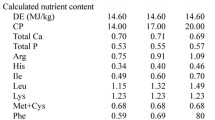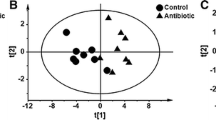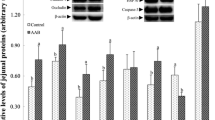Abstract
The objective of this study was to evaluate effects of dietary l-lysine on the intestinal mucosa and expression of cationic amino acid transporters (CAT) in weaned piglets. Twenty-eight piglets weaned at 21 days of age (Duroc × Landrace × Yorkshire; 6.51 ± 0.65 kg body weight) were assigned randomly into one of the four groups: Zein + LYS (zein-based diet + 1.35 % supplemental lysine), Zein − LYS (zein-based diet), NF (nitrogen-free diet), and CON (basal diet). The experiment lasted for 3 weeks, during which food intake and body weight were recorded. At the end of the trial, blood was collected from the jugular vein of all pigs, followed by their euthanasia. Dietary supplementation with lysine enhanced villus height and crypt depth in the jejunum (P < 0.05). Jejunal mRNA levels for the b0,+-AT, y+LAT1 and CAT1 genes were greater (P < 0.05) in the Zein + LYS group than in the control, and the opposite was observed for CAT1. Dietary content of lysine differentially affected intestinal CAT expression to modulate absorption of lysine and other basic amino acids. Thus, transport of these nutrients is a key regulatory step in utilization of dietary protein by growing pigs and lysine in the diet influences the expression of amino acid transporters in the small intestine.




Similar content being viewed by others
Abbreviations
- AA:
-
Amino acids
- CAT:
-
Cationic amino acid transporters
References
Blachier F, Mariotti F, Huneau JF et al (2007) Effects of amino acid derived luminal metabolites on the colonic epithelium and physiopathological consequences. Amino Acids 33:547–562
Bröer A, Wagner CA, Lang F et al (2000) The heterodimeric amino acid transporter 4F2hc/y + LAT2 mediates arginine efflux in exchange with glutamine. Biochem J 349:787–795
Chen TS, Liou SY (2012) Amino acids with basic amino side chain accelerate ability of polyphenolic compounds. Food Chem 134:9–14
Chen LX, Yin YL, Jobgen WS et al (2007) In vitro oxidation of essential amino acids by intestinal mucosal cells of growing pigs. Livest Sci 109:19–23
Chen LX, Li P, Wang JJ et al (2009) Catabolism of nutritionally essential amino acids in developing porcine enterocytes. Amino Acids 37:143–152
Dai ZL, Zhang J, Wu G et al (2010) Utilization of amino acids by bacteria from the pig small intestine. Amino Acids 39:1201–1215
Dai ZL, Li XL, Xi PB et al (2012a) Metabolism of select amino acids in bacteria from the pig small intestine. Amino Acids 42:1597–1608
Dai ZL, Li XL, Xi PB et al (2012b) Regulatory role for l-arginine in the utilization of amino acids by pig small-intestinal bacteria. Amino Acids 43:233–244
Deng JP, Yang F, Yin YL et al (2010) Effects of digestible lysine levels on growth performance, serum metabolites and carcass composition in barrows. J Food Agric Environ 8:514–518
François V, EllenI C, Carsten W et al (2004) CATs and HATs: the SLC7 family of amino acid transporter. Eur J Physiol 447:532–542
Fu WJ, Hu J, Spencer T et al (2006) Statistical models in assessing fold changes of gene expression in real-time RT-PCR experiments. Comput Biol Chem 30:21–26
Furuya WM, Graciano TS (2012) Digestible lysine requirement of Nile tilapia fingerlings fed arginine-to-lysine-balanced diets. Rev Bras Zootecn 41:485–490
Garcia-Villalobos H, Morales-Trejo A (2012) Effects of dietary protein and amino acid levels on the expression of selected cationic amino acid transporters and serum amino acid concentration in growing pigs. Arch Anim Nutr 66:257–270
Gatrell SK, Berg LE, Barnard JT et al (2013) Tissue distribution of indices of lysine catabolism in growing swine. J Anim Sci 91:238–247
Gattas GF, Silva CD (2012) Dietary digestible lysine levels in diets for barrows from 60 to 100 days of age. Rev Bras Zootecn 41:91–97
Geng MM, Li TJ, Kong XF et al (2011) Reduced expression of intestinal N-acetylglutamate synthase in suckling piglets: a novel molecular mechanism for arginine as a nutritionally essential amino acid for neonates. Amino Acids 40:1513–1522
Gu XH, Li DF, She RP (2002) Effect of weaning on small intestinal structure and function in the piglet. Archiv für Tierernaehrung 56:275–286
Guo HX, Heinamaki J, Yliruusi J (2008) Stable aqueous film coating dispersion of Zero. J Colloid Interf Sci 322:478–484
Hampson DJ (1986) Alterations in piglet small intestinal structure at weaning. Res Vet Sci 40:32–40
He QH, Kong XF, Wu GY et al (2009) Metabolomic analysis of the response of growing pigs to dietary l-arginine supplementation. Amino Acids 37:199–208
Hernández F, López M, Martínez S et al (2012) Effect of low-protein diets and single sex on production performance, plasma metabolites, digestibility, and nitrogen excretion in 1- to 48-day-old broilers. Poultry Sci 91:683–692
Hou YQ, Wang L, Zhang W et al (2012) Protective effects of N-acetylcysteine on intestinal functions of piglets challenged with lipopolysaccharide. Amino Acids 43:1233–1242
Kanai Y, Endou H (2003) Functional properties of multispecific amino acid transporters and their implications to transporter mediated toxicity. J Toxicol Sci 28:1–17
Kim SW, Wu G, Baker DH (2005) Ideal protein and dietary amino acid requirements for gestating and lactating sows. Pig News Inf 26:89–99
Li TJ, Dai QZ, Yin YL et al (2008) Dietary starch sources affect net portal appearance of amino acids and glucose in growing pigs. Animal Consortium 2:723–729
Li XL, Bazer FW, Gao HJ et al (2009) Amino acids and gaseous signaling. Amino Acids 37:65–78
Li XL, Rezaei R, Li P et al (2011a) Composition of amino acids in feed ingredients for animal diets. Amino Acids 40:1159–1168
Li FN, Yin YL, Tan BE et al (2011b) Leucine nutrition in animals and humans: mTOR signaling and beyond. Amino Acids 41:1185–1193
Mann EG, David LY, Sobrevia L (2003) Regulation of amino acid and glucose transporters in endothelial and smooth muscle cells. Physiol Rev 83:183–252
National Research Council (NRC) (1998) Swine Nutrient requirements. National Academy of Science, Washington, DC
Ren W, Yin YL, Liu G et al (2012) Effect of dietary arginine supplementation on reproductive performance of mice with porcine circovirus type 2 infection. Amino Acids 42:2089–2094
Rezaei R, Knabe DA, Li XL et al (2011) Enhanced efficiency of milk utilization for growth in surviving low-birth-weight piglets. J Anim Sci Biotech 2:73–83
Rezaei R, Knabe DA, Tekwe CD et al (2013a) Dietary supplementation with monosodium glutamate is safe and improves growth performance in postweaning pigs. Amino Acids 44:911–923
Rezaei R, Wang WW, Wu ZL et al (2013b) Biochemical and physiological bases for utilization of dietary amino acids by young pigs. J Anim Sci Biotech 4:7
Russell H, Taylor PM, Hundal HS (2003) Amino acid transporters: roles in amino acid sensing and signaling in animal cells. Biochem J 373:1–18
Seow HF, Stefan B, Angelika B et al (2004) Hartnup disorder is caused by mutations in the gene encoding the neutral amino acid transporter SLC6A19. Nat Genet 36:1003–1007
Stein ED, Chang SD, Diamond JM (1987) Comparison of different dietary amino acids as inducers of intestinal amino acid transporter. Am J Physiol 274:232–239
Sukhotnik I, Habib H, Jorge M et al (2005) Oral arginine improves intestinal recovery following ischemia–reperfusion injury in rat. Pediatr Surg Int 21:191–196
Tan B, Yin YL, Liu ZQ et al (2009) Dietary l-arginine supplementation increases muscle gain and reduces body fat mass in growing-finishing pigs. Amino Acids 37:169–175
Tan BE, Li XG, Wu G et al (2012) Dynamic changes in blood flow and oxygen consumption in the portal-drained viscera of growing pigs receiving acute administration of l-arginine. Amino Acids 43:2481–2489
Teng L, Lu CH, Zhu LG et al (2010) The biodegradation of zein in vitro and in vivo and its application in implants. Pharm Sci Tech. doi:10.1208/s12249-010-9565-y
Wang HJ, Lin ZX, Liu XM et al (2005) Heparin-loaded zero microsphere film and hemocompatibility. J Control Release 105:120–131
Wang JJ, Chen LX, Li P et al (2008) Gene expression is altered in piglet small intestine by weaning and dietary glutamine supplementation. J Nutr 138:1025–1032
Wang XQ, Ou DY, Yin JD et al (2009a) Proteomic analysis reveals altered expression of proteins related to glutathione metabolism and apoptosis in the small intestine of zinc oxide-supplemented piglets. Amino Acids 37:209–218
Wang WW, Qiao SY, Li DF (2009b) Amino acids and gut function. Amino Acids 37:105–110
Wang WC, Gu WT, Tang XF et al (2009c) Molecular cloning, tissue distribution and ontogenetic expression of the amino acid transporter b0,+ cDNA in the small intestine of Tibetan suckling piglets. Comp Biochem Physiol 154:157–164
Wang WW, Wu ZL, Dai ZL et al (2013) Glycine metabolism in animals and humans: implications for nutrition and health. Amino Acids. doi:10.1007/s00726-013-1493-1
Wei JW, Carroll RJ, Harden KK et al (2012) Comparisons of treatment means when factors do not interact in two-factorial studies. Amino Acids 42:2031–2035
Wolfram S, Giering H, Scharrer E (1984) Na+-gradient dependence of basic amino acid transporter into rat intestinal brush border membrane vesicles. Biochem Physiol 78:475–480
Wu G (2009) Amino acids: metabolism, functions, and nutrition. Amino Acids 37:1–17
Wu G (2010a) Recent advances in swine amino acid nutrition. J Anim Sci Biotech 1:49–61
Wu G (2010b) Functional amino acids in growth, reproduction and health. Adv Nutr 1:31–37
Wu G (2013a) Amino acids: biochemistry and nutrition. CRC Press, Boca Raton, p 503
Wu G (2013b) Functional amino acids in nutrition and health. Amino Acids. doi:10.1007/s00726-013-1500-6
Wu G, Meier SA, Knabe DA (1996) Dietary glutamine supplementation prevents jejunal atrophy in weaned pigs. J Nutr 126:2578–2584
Wu G, Bazer FW, Davis TA et al (2009) Arginine metabolism and nutrition in growth, health and disease. Amino Acids 37:153–168
Wu G, Wu ZL, Dai ZL et al (2013) Dietary requirements of “nutritionally nonessential amino acids” by animals and humans. Amino Acids 44:1107–1113
Yang CB, Albin DM, Wang ZR et al (2011) Apical Na+-D-glucose co-transporter 1 (SGLT1) activity and protein abundance are expressed along the jejunal crypt–villus axis in the neonatal pig. Am J Physiol Gastrointest Liver Physiol 300:60–70
Yao K, Li TJ, Huang RL et al (2011) Dietary l-arginine supplementation enhances intestinal development and expression of vascular endothelial growth factor in weanling piglets. Br J Nutr 105:703–709
Yao K, Yin YL, Li XL et al (2012) Alpha-ketoglutarate inhibits glutamine degradation and enhances protein synthesis in intestinal porcine epithelial cells. Amino Acids 42:2491–2500
Yin YL, Huang RL, de Lange CFM et al (2004) Effect of including purified Jack Bean lectin in a casein based diet on apparent and true ileal amino acid digestibility in growing pigs. Anim Sci 79:283–291
Yin FG, Zhang ZZ, Huang J et al (2010a) Digestion rate of dietary starch affects systemic circulation of amino acids in weaned pigs. Br J Nutr 103:1404–1412
Yin YL, Huang RL, Li TJ et al (2010b) Amino acid metabolism in the portal-drained viscera of young pigs: effects of dietary supplementation with chitosan and pea hull. Amino Acids 39:1581–1587
Yin YL, Yao K, Liu ZJ et al (2010c) Supplementing l-leucine to a low-protein diet increases tissue protein synthesis in weanling pigs. Amino Acids 39:1477–1486
Yin FG, Yin YL, Li TJ (2011) Developmental changes of serum amino acids in suckling piglets. J Food Agric Environ 9:322–327
Zhi AM, Zuo JJ, Zhou XY (2010) The Influence of different lysine concentration on the cationic amino acid transporter mRNA expression of porcine IEC. Chinese Agric Sci Bull 26:6–11
Zhou XH, Wu X, Yin YL et al (2011) Preventive oral supplementation with glutamine and arginine has beneficial effects on the intestinal mucosa and inflammatory cytokines in endotoxemic rats. Amino Acids. doi:10.1007/s00726-011-1137-2
Acknowledgments
This research was jointly supported by grants from National Basic Research Program of China (2013CB127301), National Natural Science Foundation of China (31272463, 31110103909), Hunan strategy emerging industry science research project (2011GK4061), the Chinese Academy of Sciences Visiting Professorship for Senior International Scientists Grant No. 2011T2S15), and Texas A&M AgriLife Research Hatch project (H-8200).
Conflict of interest
The authors declare that they have no conflict of interest.
Author information
Authors and Affiliations
Corresponding authors
Rights and permissions
About this article
Cite this article
He, L., Yang, H., Hou, Y. et al. Effects of dietary l-lysine intake on the intestinal mucosa and expression of CAT genes in weaned piglets. Amino Acids 45, 383–391 (2013). https://doi.org/10.1007/s00726-013-1514-0
Received:
Accepted:
Published:
Issue Date:
DOI: https://doi.org/10.1007/s00726-013-1514-0




